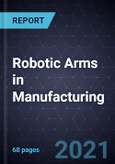A robotic arm is a programmable mechanical arm that consists of actuators placed at the joints to enable different functions and handle varying payloads, similar to how the human arm works. Some common activities performed by robotic arms include: picking and placing, sorting, welding, screwing, machine tending, painting, and injection molding. In general, robotic arms are viewed as “industrial robots” and carry out repetitive as well as dangerous processes; they complete certain tasks faster and more efficiently than humans do and are designed to perform with higher accuracy.
The automotive industry has experienced the highest adoption volume as several manufacturers are using robots to carry out welding, picking-and-placing, material handling, and machine-tending applications. However, the need for automation in manufacturing to meet mass production and customer demands and to lower worker strain triggered the adoption of robotic arms in other industries, such as healthcare and oil and gas.
Collaborative robots, or cobots, are a subset of industrial robotic arms that are, however, better equipped (integrated with sophisticated vision technology, sensors, and artificial intelligence [AI]) to carry out the precise handling of materials, such as working with semiconductors.
Analysis of the robotic arm value chain shows 3 primary areas of focus for robotic OEMs: cost reduction, product differentiation, and after-sales service to enable effective customer reach. Robotic solution OEMs are engaging different modes of channel partners to develop low-cost robotic tools.
Key Questions Answered in the Technology and Innovation Study
- What is robotic arm technology?
- What is the application landscape of robotic arm technology and the different industry verticals where it is applicable?
- What are the influencing factors driving opportunities for robotic arms?
- What are the technology capabilities of robotic arms?
- What are the industry best practices?
- What does analysis of the IP scenario and value chain reveal?
- What are the growth opportunities and critical success factors for this technology?
Table of Contents
1.0 Strategic Imperatives
1.1 Why Is It Increasingly Difficult to Grow? The Strategic Imperative 8™: Factors Creating Pressure on Growth
1.2 The Strategic Imperative 8™
1.3 The Impact of the Top Three Strategic Imperatives on Robotic Arms in Manufacturing
1.4 About the Growth Pipeline Engine™
1.5 Growth Opportunities Fuel the Growth Pipeline Engine™
2.0 Growth Opportunity Analysis
2.1 Scope of Technology and Innovation Research
2.2 Research Methodology
2.3 Research Process and Methodology
2.4 Key Findings
3.0 Robotic Arms, Technology Landscape
3.1 Robotic Arms, Technology Overview
3.2 Industrial Applications Based on Robot Arm Type
3.3 Industrial Applications of Robot Arms
3.4 Other Applications of Industrial Robots Include Gluing, Soldering, and Cutting
3.5 Architecture of the Robotic Arm: Sensors and End Effectors Aid Seamless Robotic Operation
3.6 Enabling Sensor Technologies Working in Collaboration with Robotic Arms
3.7 Manufacturing Industries and Applications Impacted by Industrial Robotics
3.8 Recent Research Indicates Advancements in AI Will Enable a New Breed of Robotic Arms
4.0 Implementation Case Scenario
4.1 Use Case 1: Zippertubing, US and Universal Robots, Denmark
4.2 Use Case 2: Ford, US and Universal Robots, Denmark
4.3 Use Case 3: MAGNA Presstec, Austria and KUKA, Germany
4.4 Use Case 4: Absolicon, Sweden and ABB, Switzerland
5.0 Factors Influencing Adoption of Robotic Arms
5.1 Factors Driving Technology Development and Adoption: Increased Throughput and Production Flexibility
5.2 Factors Challenging Technology Development and Adoption: Lack of Interoperability Standardization
6.0 Assessment of Industry Best Practices, Patent Trends, and Value Chain Analysis
6.1 Automotive Manufacturers Expand Use of Robotic Arms at Their Factories
6.2 Strategic Alliances Enable Better Customer Reach
6.3 Collaborative Robots with Advanced Controllers and Higher Payloads Enable Precise Operations
6.4 Patent Assessment of Robotic Arms
6.5 Patent Filing Shows Potential Application for Robotic Arms beyond Manufacturing Sector
6.6 Robotic Arms Value Chain Analysis Indicates Robotic Manufacturers Opt for Different Routes to Market
7.0 Companies to Action
7.1 ABB, Switzerland
7.1.1 Dual Arm Collaborative Robot
7.2 KUKA, Germany
7.2.1 Collaborative Robot Arm Enables Medical Assistance
7.3 FANUC, Japan
7.3.1 Collaborative Robot Arm Enables Assembly and Machine Tending
7.4 Yaskawa Motoman, US
7.4.1 Collaborative Robot Arm Enables Inspection of Electronics
7.5 Flexiv, US
7.5.1 Adaptive Robotic Arm Leads to Next Generation of Cobots
8.0 Impact of COVID-19
8.1 Adoption of Collaborative Robots Creates Flexible Manufacturing Lines
8.2 Cobots Transform Manufacturing Floor to Aid Mass Production of Ventilators
8.3 Universal Robots Supplies Cobots to Enable Resilience at Industrial Sites Adapting to the Dynamic COVID-19 Scenario
9.0 Growth Opportunities
9.1 Growth Opportunity 1: New Product Launches Enable Scope of Adoption for SMEs
9.2 Growth Opportunity 2: IP Scenario Driven Extensively by Advancements in Navigation, Localization, and Mapping
9.3 Growth Opportunity 3: Distribution Channel Optimization for Better Reach of Robotics OEMs
10.0 Key Contacts
10.1 Key Contacts
11.0 Next Steps
11.1 Your Next Steps
11.2 Why Frost, Why Now?
Legal Disclaimer
Companies Mentioned (Partial List)
A selection of companies mentioned in this report includes, but is not limited to:
- Flexiv
- Yaskawa Motoman
- FANUC
- KUKA
- ABB








